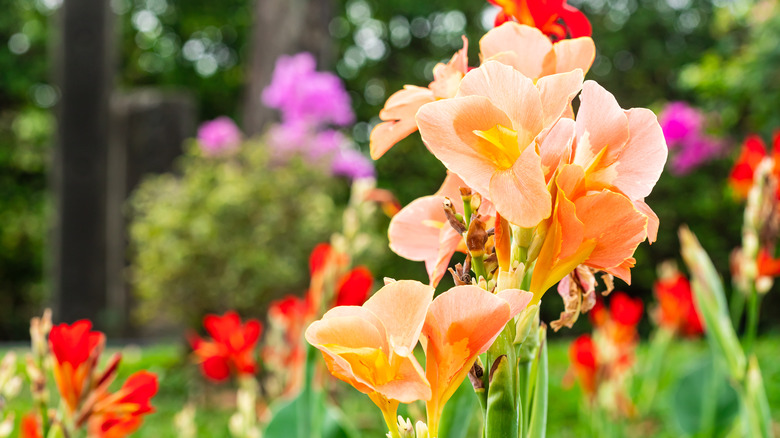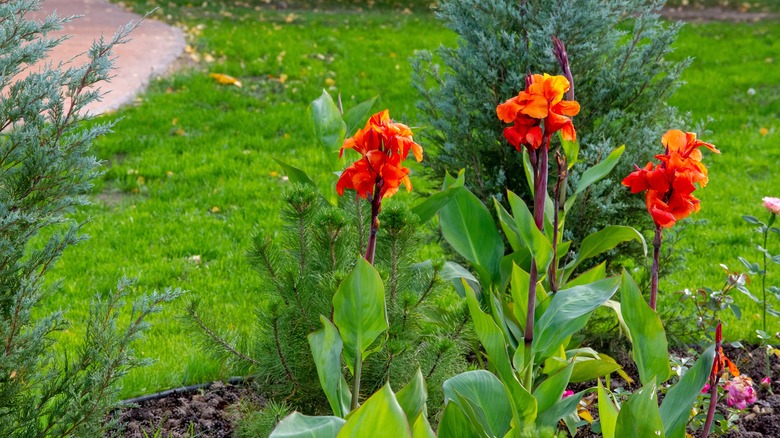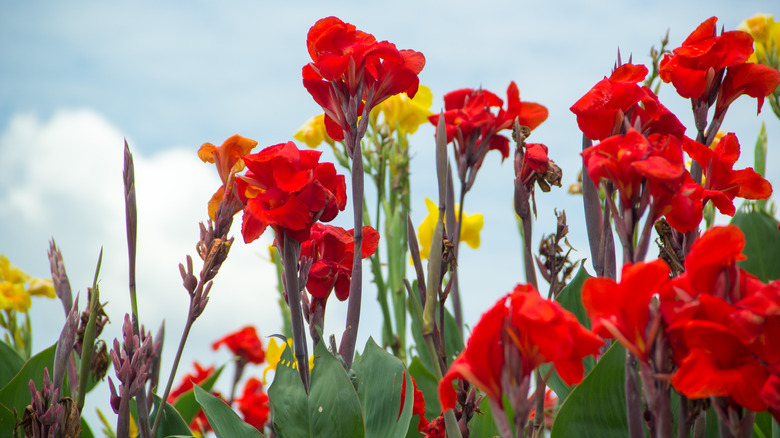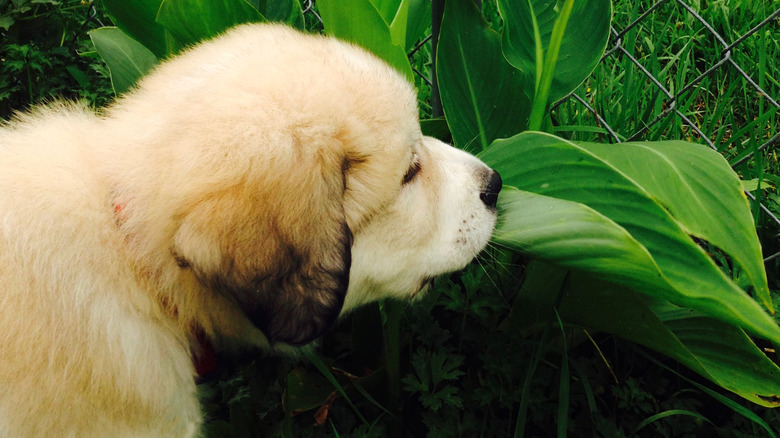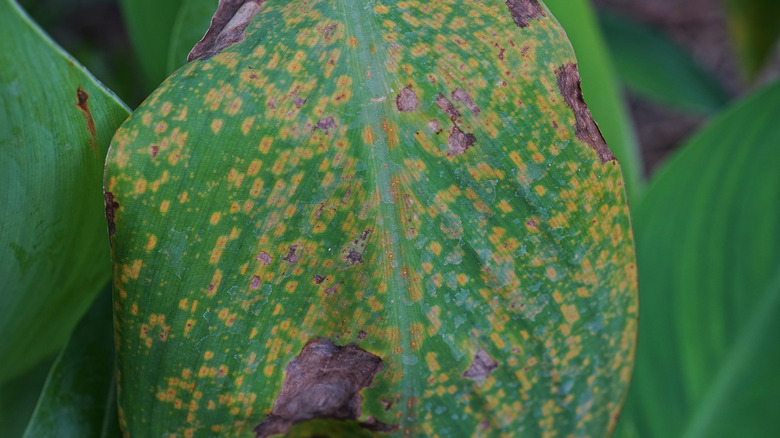How To Grow And Take Care Of Canna Lilies
Canna lilies (scientific name: canna), also known simply as cannas, are a member of the Cannaceae family. They are not actually a type of lily and are similar in appearance to the iris flower. This tropical plant is marked by large, green leaves and blooms that come in a range of colors, including yellow, red, purple, pink, white, and even multi-colored, as per the University of Minnesota Extension. You may be surprised to learn that the blooms are actually a type of leaf. They are shaped like mini trumpets and grow upwards in clusters, hiding the much smaller flowers within. Most canna lilies grow to heights of between 4 and 6 feet and bloom from spring well until the first frost in the late fall, according to Almanac.
The canna lily has a fascinating history that spans hundreds of years, reveals The Garden of Eden. They were brought from newly colonized North and South American regions to Europe by Dutch botanist Charles de l'Ecluse in the 1500s. At the time, Dutch colonists were optimistic that canna lilies could be grown and sold as a food crop. However, from the 19th century onward, it became more of an exotic garden feature rather than a crop sold for human consumption.
If you're considering planting canna lilies in your garden, you've come to the right place. Read through the following guide to learn everything you need to know about growing and caring for this gorgeous plant.
How to use canna lilies in the garden
Canna lilies are the star of any garden and should be planted to reflect this. Garden Design recommends planting more than one canna lily in any given place to create a greater visual impact. They can be planted in garden beds or along fences, walls, and other barriers in your yard. If you have a pathway in your yard, consider lining the sides with canna lilies to feel like you are walking through a colorful tunnel. Water-loving canna lily varieties are also the perfect candidate for planting next to small ponds or bogs where they will thrive in the moist soil and brighten up the area with their blooms.
For smaller yards or patios and decks, canna lilies can be planted in large containers that provide enough room for their roots to stretch out and keep them grounded as they grow. Growing them in pots provides the perfect opportunity to mix and match colors both within the canna lily family as well as outside. Almanac points out a few of the canna lily's favorite growing companions, including elephant ears, zinnias, periwinkles, snapdragons, and any variety of ornamental grass. Due to their tendency to grow upward instead of outward, canna lilies can also be planted in any narrow space within your garden that you feel is lacking a bit of plant life. You can also find smaller varieties that are great for planting at the front of garden beds.
How to grow canna lilies
Canna lilies are grown from rhizomes, or tubers, that are planted directly in the soil, according to Gardenia. You will need to purchase the desired number of rhizomes from your local plant nursery and gather a shovel, a bag of mulch, and a pair of gardening gloves to get to work. Due to their tropical nature, canna lilies are picky about the time of year they like to be planted. You should make sure that any potential threat of frost has passed in the spring before planting them. If you plant before the winter, they will die before getting the chance to grow. The soil temperature is also crucial and shouldn't measure below 65 degrees Fahrenheit.
While all rhizomes should be planted about 4 inches into the ground, the distance between each hole will depend on the size of the varieties you choose and will range from around 18 inches to 3 feet. Once you've dug your holes, it's important to mix in some nutrient-rich manure or compost into the soil. Next, you'll place one rhizome in each hole with the eye facing toward the sky. This will ensure the plant grows upward rather than down into the soil. Fill in each hole will soil and spread a layer of mulch over the top before watering. While your canna lilies grow, you should make sure the soil stays moist at all times. As soon as you notice the first blooms, the frequency can be reduced.
How to care for canna lilies
Canna lilies aren't a super fussy plant but there are certain conditions that must be met for them to thrive in your garden. One of the most important factors is that they are grown in the proper USDA hardiness zone. This includes zones 7 through 10, all of which are located in warmer regions of the United States, as per The Spruce. If the region you live in experiences cold winters, your canna lilies will die if left in the ground. In this case, you will need to cut back any foliage, dig up the rhizomes, and store them indoors through the winter.
The canna lily is also a sun-loving plant, requiring direct light throughout the day. It won't die if planted in an area with partial sun, but will need less water. You will need to make sure your canna lilies get enough water throughout the growing season as well without overly saturating the soil. Too much water can lead to fungal diseases and root rot. If you live in an area with little to no rainfall, aim for one to two waterings per week.
In addition to water, canna lilies also need plenty of food in the form of fertilizer. They should be given a phosphorous-dense fertilizer once a month for optimum health. You should also note that canna lilies will grow best if they are pruned throughout the growing season. This involves pinching off any dead blooms to encourage new growth.
Varieties of canna lilies
Canna lilies (scientific name: canna) hail from tropical and sub-tropical regions in North and South America, as per Plant Delights Nursery, Inc. You can find 19 species within the canna genus that feature varieties of numerous sizes and colors, according to Gardenerdy. From these 19 species, botanists have also created hybrid versions of the plant that experiment with combining colors and other features.
Among the varieties is the canna amabilis, which draws the eye with its dark red and yellow blooms. It is a shorter variety of canna lily, reaching heights between 2 and 4 feet when fully grown. A popular dwarf variety is known as canna compacta, which hits heights of 2 feet and is perfect for sitting at the front of garden beds or in containers. There are also a few varieties of water canna that grow in bodies of water. Among them is canna flaccida, which boasts large and stunning yellow blooms and is native to the southern U.S. wetlands. If you want a canna variety with plenty of height, go for the canna iridiflora, which reaches 5 feet when mature. The flowers are a pleasant pink and red as well. Canna tuerckheimii is yet one more taller variety of canna lily with a fully grown height of between 4 and 5 feet. It also features fiery-red and orange blooms and extra-large leaves resembling those of the banana plant.
Are canna lilies toxic?
Not only are canna lilies not toxic to humans, they can also be consumed, as per Plant Delights Nursery, Inc. The website points out that prior to modern-day agriculture, the rhizome was a staple of indigenous cuisines. Nowadays, it has mostly been replaced by other starches, including corn and potatoes. In some parts of the world, however, the rhizome is still a crucial food source. The Vietnamese turn the rhizomes into noodles and incorporate them into a number of traditional dishes. The canna lily is also a food crop in many South American regions. The rhizome isn't the only part of the plant that can be consumed either — the foliage can also be added to salads or other dishes, according to SFGate.
If you have furry family members running around, you might be wondering if canna lilies are also non-toxic to them. Fortunately, the ASPCA lists canna lilies as non-toxic to dogs, cats, and horses, making it a great option for pet households. Note that while you can allow your curious dogs and cats to munch on your canna lilies without worrying about toxication, it is best to prevent them from doing so whenever possible to avoid harm to the plants. If your pet is destructive or excessively eats your plants, you may want to consider putting up fences or barriers to block their access. You can also purchase bitter sprays to dissuade them from munching on your canna lilies.
How to repot canna lilies
Canna lilies grow well in pots as long as the size of the container is adequate. Gardening Know How advises gardeners to start with a large pot to give their canna lilies space to spread their roots and get a good hold on the soil. However, you may find that your canna lilies outgrow their containers and need an upgrade. It is time to purchase a larger container if you notice that the plant roots are growing out of the drainage holes at the bottom of the pot. You may also find that when you water your canna lilies, the water flows directly through the soil into the base of the pot. This is a sign that the soil-to-root ratio is off and your plant is in need of additional soil.
To repot your canna lilies, you should look for a container that is one size larger than the current one and purchase a quality potting soil to go with it. Canna lilies will thrive in most containers as long as it is sturdy enough to support their continued growth. Once you've gathered your materials, spread a layer of potting soil at the base of the new container. Next, gently remove the canna lily from its old pot and clear the roots of any soil. You may also want to loosen them a bit if they've become bound. Place the plant in the new pot and fill it in with more soil. Finally, water generously.
Canna lily pests and diseases
Canna lilies are the target of a number of different pests and diseases. If you notice that your canna lily appears unhealthy or has been infected by an insect or illness, don't fret as treatments are available for most afflictions.
Gardening Know How alerts canna lily owners to a common disease specific to this plant, known as canna rust. The condition is caused by a fungal infection and leads to yellow-brown spots along the leaves and stems. If left untreated, you'll notice that the leaves begin to turn brown, shrivel up, and die. This disease poses a huge threat to your canna lilies because of the way it spreads. The fungus deposits spores on the leaves that eventually burst and are carried on the wind to neighboring individuals. You will need to stay attentive to the development of this disease to avoid it killing off all your canna lilies. Fortunately, it can be treated with copper fungicides. Any infected individuals will need to be properly disposed of in a trash bin.
In addition to fungal diseases, your canna lilies are a target for a variety of insect pests, as per SFGate. The most common are spider mites, thrips, and leafrollers. All of these insects use your canna lilies as a food source and can cause enough damage over time that the entire plant will cease to thrive. To treat insect infestations, you will likely need to resort to an insecticide soap or spray.
